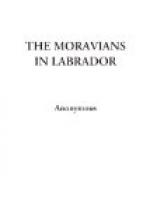Salmon and salmon-trout are caught in every creek and inlet; they remain in the rivers and fresh-water lakes during the winter, and return to the sea in spring. The Esquimaux about Okkak and Saeglak, catch them in winter under the ice by spearing. For this purpose they make two holes in the ice, about eight inches in diameter, and six feet asunder, in a direction from north to south. The northern hole they screen from the sun by a bank of snow about four feet in height, raised in a semi-circle round its southern edge, and form another similar bank on the north side of the southern hole, sloped in such a manner as to reflect the rays of the sun into it. The Esquimaux then lies down, with his face close to the northern aperture, beneath which the water is strongly illuminated by the sunbeams entering at the southern. In his left hand he holds a red string, with which he plays in the water to allure the fish, and in his right, a spear ready to strike them as they approach; and in this manner, they soon take as many as they want. The trout on this coast are from twelve to eighteen inches long, and in August and September so fat, that the Esquimaux collect from them a sufficient quantity of oil for their lamps. The great shoals of herrings, which are the staple of the Greenlanders, do not touch at the shores of Labrador, but they have abundance of cod at many of their fishing stations, which the missionaries have shown them the method, and set them the example, of curing for their winter’s supply.
Sea-fowl of the duck and goose species frequent the shores of Labrador, and the islands scattered around it, and afford to the natives, as they do to the rest of the northern tribes, food, warmth, and materials for trade. Of the land birds, the large partridge, [reiper,] or American wild pheasant, is the only one which the missionaries mention as being used by them as an agreeable variety of food, when, other resources failing, they have been confined to salted provisions.
The peninsula is chiefly inhabited on the coast, where the Moravians have now four settlements. The natives style themselves Innuit, i.e. men; and foreigners, Kablunat or inferior beings. Their original national name is Karalit, also denoting superiority, and the term Esquimaux, by which they are now so generally known, was given them by their neighbours the Indians, in whose language it signifies “men’s raw meat,” and probably imports that the Indians were, or it may be, are cannibals, and devoted their captives for this horrible repast. In lowness of stature, in their flat features, and dark colour, they exactly resemble the Greenlanders. Their language is a dialect of the same tongue, intelligible by both; but from their intercourse with foreigners, and their adopting some foreign customs, and becoming possessed of foreign utensils, a number of strange words have been introduced into each, only the former borrowed Danish or English phrases, while the latter had learned many French words. Their dress is nearly similar, being seal-skin coats and breeches, except the outer garment of the women ends behind in a train that reaches to the ground, and their boats are sufficiently large to carry their children if they are mothers—or provisions, or any other packages, if they are not.




